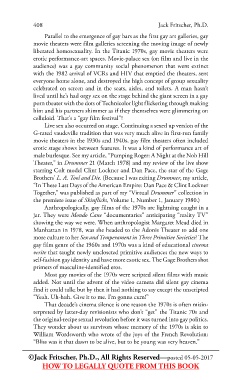Page 428 - Gay San Francisco: Eyewitness Drummer - Vol. 1
P. 428
408 Jack Fritscher, Ph.D.
Parallel to the emergence of gay bars as the first gay art galleries, gay
movie theaters were film galleries screening the moving image of newly
liberated homosexuality. In the Titanic 1970s, gay movie theaters were
erotic performance-art spaces. Movie-palace sex (on film and live in the
audience) was a gay community social phenomenon that went extinct
with the 1982 arrival of VCRs and HIV that emptied the theaters, sent
everyone home alone, and destroyed the high concept of group sexuality
celebrated on screen and in the seats, aisles, and toilets. A man hasn’t
lived until he’s had orgy sex on the stage behind the giant screen in a gay
porn theater with the dots of Technicolor light flickering through making
him and his partners shimmer as if they themselves were glimmering on
celluloid. That’s a “gay film festival”!
Live sex also occurred on stage. Continuing a sexed up version of the
G-rated vaudeville tradition that was very much alive in first-run family
movie theaters in the 1930s and 1940s, gay film theaters often included
erotic stage shows between features. It was a kind of performance art of
male burlesque. See my article, “Pumping Roger: A Night at the Nob Hill
Theater,” in Drummer 21 (March 1978) and my review of the live show
starring Colt model Clint Lockner and Dan Pace, the star of the Gage
Brothers’ L. A. Tool and Die. (Because I was exiting Drummer, my article,
“In These Last Days of the American Empire: Dan Pace & Clint Lockner
Together,” was published as part of my “Virtual Drummer” collection in
the premiere issue of Skinflicks, Volume 1, Number 1, January 1980.)
Anthropologically, gay films of the 1970s are lightning caught in a
jar. They were Mondo Cane “documentaries” anticipating “reality TV”
showing the way we were. When anthropologist Margaret Mead died in
Manhattan in 1978, was she headed to the Adonis Theater to add one
more culture to her Sex and Temperament in Three Primitive Societies? The
gay film genre of the 1960s and 1970s was a kind of educational cinema
verite that taught newly uncloseted primitive audiences the new ways to
self-fashion gay identity and have more exotic sex. The Gage Brothers shot
primers of masculine-identified eros.
Most gay movies of the 1970s were scripted silent films with music
added. Not until the advent of the video camera did silent gay cinema
find it could talk; but by then it had nothing to say except the unscripted
“Yeah. Uh-huh. Give it to me. I’m gonna cum!”
That decade’s cinema silence is one reason the 1970s is often misin-
terpreted by latter-day revisionists who don’t “get” the Titanic 70s and
the original-recipe sexual revolution before it was turned into gay politics.
They wonder about us survivors whose memory of the 1970s is akin to
William Wordsworth who wrote of the joys of the French Revolution:
“Bliss was it that dawn to be alive, but to be young was very heaven.”
©Jack Fritscher, Ph.D., All Rights Reserved—posted 05-05-2017
HOW TO LEGALLY QUOTE FROM THIS BOOK

